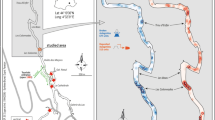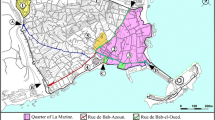Abstract
For much of the African continent archaeological fieldwork is still at an exploratory stage. There must be a great difference between the known archaeological evidence, on which we base our hypotheses, and the evidence that remains to be discovered. There must, in addition, be a veritable gulf between the archaeological evidence we have and the prehistoric human behaviour that we seek to understand. The following paper discusses recent field work in southern Borno in the light of these ideas. This fieldwork aimed to test an hypothesis about human exploitation of the area before 3000 bp but succeeded instead in revealing a substantial number of later sites in a part of an area already previously investigated by the writer. So far as earlier sites are concerned, this new fieldwork suggests that future archaeological exploration should be concentrated on the northern end of the Mandara Mountains and on the deposits at their base. The overall lesson of this fieldwork, however, seems to be that the harder you look, the more you find—although you may not find what you are looking for.
Résumé
Presque partout en Afrique, le travail archéologique sur le terrain n'en est qu'au stade exploratoire. Il y a sans doute un grand écart entre les données archéologiques connues sur lesquelles se fondent nos hypothèses, et les faits qu'il reste à découvrir. De plus, il existe vraisemblablement un veritable gouffre entre les données archéologiques que nous possédons et le comportement humain préhistorique que nous cherchons à comprendre. Le présent article discute les recherches récentes au sud du Borno en tenant compte de ces idées. Ces travaux visaient la mise à l'essai d'une hypothèse portant sur l'exploitation humaine de la région avant 3000 ans bp mais en vint plutôt à révéler un nombre considérable de sites plus tardifs dans une aire déjà étudiée par l'auteur dans la même région. Quant aux sites de date plus éloignée, les nouveaux travaux sur le terrain suggèrent que l'exploration archéologique devrait dorénavant se concentrer sur l'extrémité nord des montagnes Mandara et sur les dépôts à leurs pieds. Il en ressort surtout, cependant, que plus on cherche, plus on découvre, bien qu'on ne trouve pas toujours ce que l'on cherchait.
Similar content being viewed by others
References
Bawden, M. G. 1972. Geomorphology. InThe land resources of North East Nigeria (ed. P. Tuley): vol. 1, pp. 60–70 and map 2. Surbiton.
Connah, G. 1978. Aborigine and settler: archaeological air photography.Antiquity 52:95–99.
Connah, G. 1981.Three thousand years in Africa: man and his environment in the Lake Chad region of Nigeria. London: Cambridge University Press.
Connah, G. and Jemkur, J. 1982a. Prospecting the 3000 BP barrier: Borno 1981.Nyame Akuma 20:35–43.
Connah, G. and Jemkur, J. 1982b.Borno 1981: an archaeological fieldwork tour organized by the Centre for Nigerian Cultural Studies, Ahmadu Bello University, Zaria, Nigeria, and the Department of Prehistory and Archaeology, University of New England, Australia. Unpublished report, Department of Prehistory and Archaeology, University of New England.
Daniels, S. G. H. 1972. Research design models. InModels in archaeology (ed. D. L. Clarke): pp. 201–29. London: Methuen.
Foley, R. 1981.Off-site archaeology and human adaptation in Eastern Africa: an analysis of regional artefact density in the Amboseli, Southern Kenya. Cambridge Monographs in African Archaeology 3, BAR International Series 97, Oxford.
Isaac, G. Ll. and Harris, J. W. K. 1980. A method for determining the characteristics of artefacts between sites in the Upper Member of the Koobi Fora Formation, East Lake Turkana. InProceedings, VIIIth Panafrican Congress of Prehistory and Quaternary Studies (eds R. E. Leakey and B. A. Ogot): pp. 19–22. Nairobi: The International Louis Leakey Memorial Institute for African Prehistory.
Nigeria, 1969. 1:50,000 survey maps: Gwoza SW, Sheet 114 SW, Edition 1 and Gwoza SE, Sheet 114 SE, Edition 1.
Sassoon, H. 1964. Iron-smelting in the hill village of Sukur, North-Eastern Nigeria.Man 64:174–78.
Sullivan, S. in press. Making a discovery: the finding and reporting of Aboriginal sites. InAustralian field archaeology: a guide to techniques (ed. G. Connah) Canberra: Australian Institute of Aboriginal Studies.
Thomas, D. H. 1979.Archaeology. New York: Holt, Rinehart and Winston.
Williams, C. F. 1980.Vacuuming Mt Yarrowyck: a comprehensive survey of one stratified zone of the New England Tablelands. B.A. (Hons) Thesis, Department of Prehistory and Archaeology, University of New England.
Rights and permissions
About this article
Cite this article
Connah, G. An archaeological exploration in southern Borno. Afr Archaeol Rev 2, 153–171 (1984). https://doi.org/10.1007/BF01117230
Issue Date:
DOI: https://doi.org/10.1007/BF01117230




